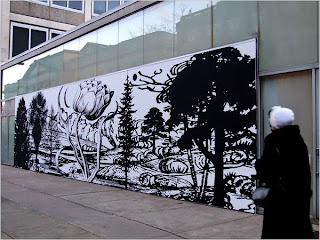On Monday, I will be set up in Steinberg lobby to collect submissions. Stop by!
Sunday, February 21, 2010
FRESH BREAD
On Monday, I will be set up in Steinberg lobby to collect submissions. Stop by!
Saturday, February 13, 2010
Offset

After yesterday's photolithography demo and the discussion of the word "offset" I thought I would post a bit about the process. When I was in graduate school, and actually, undergrad as well, I often used an offset press called a DUFA for photolitho and monotyping. The press consisted of two beds and a complicated inking/dampening system that could be run manually or with electricity. You put your plate on one bed, inked it, then rolled a large rubber blanket over the image area, which "offset" from the plate to the blanket. From there, the rubber blanket printed onto your paper on the second press bed. It was a great way to work monotypes-you could make changes to the plate or even the blanket before you printed on your paper. Ghosting was easy and subtle.
I had the chance a few times to work with someone to run the press automatically. There were sponging rollers and inking rollers, and if everything went well you could stand back and watch the photolitho plates being printed for you. In my studio, I have several examples of monoprints done using the DUFA. If anyone would like to see them, please let me know!
From Wikipedia, a definition of offset:
Offset printing is a commonly used printing technique where the inked image is transferred (or "offset") from a plate to a rubber blanket, then to the printing surface. When used in combination with the lithographic process, which is based on the repulsion of oil and water, the offset technique employs a flat (planographic) image carrier on which the image to be printed obtains ink from ink rollers, while the non-printing area attracts a water-based film (called "fountain solution"), keeping the non-printing areas ink-free.
Development of the offset press came in two versions: in 1875 by Robert Barclay of England for printing on tin, and in 1903 by Ira Washington Rubel of the United States for printing on paper.
In our shop, because we hand print offset plates without the use of a rubber blanket, we often have to tweak the inking or pressure to get a good impression from our plate. Isn't pkmg a grand, complicated beast?
Monday, February 8, 2010
Philagrafika Review

An interesting article from Friday's NY Times-a must read for all you up and coming printmakers!
http://www.nytimes.com/2010/02/05/arts/design/05philagrafika.html?pagewanted=2&sq=printmaking&st=cse&scp=1
And slideshow:
http://www.nytimes.com/slideshow/2010/02/05/arts/20100205-PHILA_index.html
Friday, February 5, 2010
Reconfiguring Collage History!

